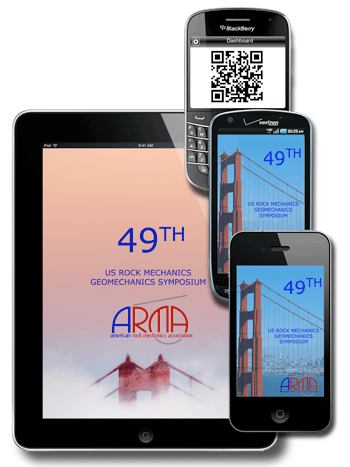Program/Keynotes
 |
Announcing the 2015 ARMA App!
Enhance your attendee and exhibitor experience by downloading for your device. Search "2015 US Rock Mechanics" in the App Store or Google Play. All others Click image or HERE to download to your device. |
CLICK HERE to download Program at a Glance
CLICK HERE to download Program
CLICK HERE to download List of Paper Topics and Authors
CLICK HERE to download information on the Symposium App
CLICK HERE to access MIRA Site
Interdisciplinary
- Coupled Process Modeling
- Salt Rock Mechanics-Experimental Characterization, Theoretical Modeling and Geological Storage Applications
- Effect of Chemical and Mechanical interactions on Permeability and brittle Deformation
- Geothermal: Hurdles to a Successful EGS Operation-Closing Critical Knowledge Gaps
- Uncertainty: Assessment and Quantification for Rock Engineering Design
- Geophysical Properties of Rock and Their Characterization
- Acoustic Emission: Fracture Monitoring from Laboratory to Field Scale
- Multiphase, Multi-component and Particulate Fluid Flow in Fractured Rock
- Coupled Processes in CO2 Sequestration and Hydraulic Fracturing
- Thermal, Hydrological, Mechanical, Chemical and Biological Influences upon Rock
- Measurement/Modeling of Rock Properties
- New Developments in Computational Rock Mechanics/High-Performance Computing
- Rock Heterogeneity and Scaling
- Geologic Repository Issues for Nuclear Waste Disposal
- General: Interdisciplinary
Mining
- Deep Mine Rock Mechanics
- Hard Rock Ground Control
- Coal Mining Ground Control
- Cave Mining Geomechanics
- Mining Geomechanics
- Numerical Modeling-Mining
- Case Histories-Coal
- Case Histories-Mining
- Mining-Induced Seismicity
- Outbursts and Bumps
- Subsidence Geomechanics
- Ground Support Design
- Mining Rock Slopes
- General: Mining
Civil
- Laboratory Testing
- Field Testing
- Failure Behavior and Constitutive Modeling
- Rock Mass Characterization
- Rock Mass Strength and Deformability Modeling of Fractured Media
- Slope Stability and Landslides
- Ground Subsidence
- Induced Seismicity
- Other Hazard Prediction and Mitigation
- Environmental Issues
- Ground Improvement
- Tunnels and Caverns
- Dams and Foundations
- Other Rock Mechanics for Infrastructure
- Rock Dynamics
- General
Petroleum
- 3D Simulation of Complex Fracture Growth
- Cap Rock Integrity
- Coastal Subsidence
- Constitutive Models
- Coupled Process
- Discrete Fracture Networks
- Experimental Rock Mechanics
- Fracture Mechanics
- Geomechanics for Unconventionals
- Hydraulic Fracture-Novel Technologies
- Hydraulic Fracture-Simulations
- Hydraulic Fractures-Monitoring
- Petroleum-Related Salt Mechanics
- Reservoir Geomechanics
- Wellbore and Drilling Mechanics
- In Situ Stress Measurement
- Pore Pressure Prediction
- Geomechanics for Near-Surface and Shallow Hazards
- Carbonates
- Geomechanics and Reservoir Surveillance
- Geomechanics and Enhanced Oil Recovery
- General: Petroleum
Keynote Speakers
MTS Lecture
Sunday, 28 June
Thermo-Poro-Mechanics of Shear Localization in Rapidly Sheared Granular Rock and Implications for Earthquake Source Physics
 Professor James R. Rice
Professor James R. Rice
Mallinckrodt Professor of Engineering Sciences and Geophysics
School of Engineering and Applied Sciences and the
Department of Earth and Planetary Sciences
Harvard University
Field observations of mature, well-slipped, earthquake fault zones show that the majority of shear is often localized to principal slipping zones of order 10-100 microns width within a broader gouge layer of order 10-100 mm wide (with all that being a feature located within a much broader, 1-10s m wide, damage zone bordering the fault). Such fault gouges are often rate-strengthening, especially at higher temperatures, and are then resistant to shear localization under typically slow laboratory deformation rates. Extreme localization is, instead, a predicted consequence of rapid straining, with related shear heating, for realistically fluid-infiltrated gouge on time scales that are too short for significant fluid drainage or heat conduction. Localization is due to development of highly elevated pore pressure. Results are presented for two versions of the process: In the classical one, the pore fluid pre-exists in the gouge as groundwater. In another, thermal decomposition reactions in hydrated silicates (clays, serpentines) or carbonates within gouge are triggered as temperature rises, releasing a volatile phase (H2O or CO2) at high pressure. Results have implications for the mode of slip-rupture propagation in earthquakes (self-healing vs. crack-like) and shed new light on why statically strong faults like the SAF can produce large ruptures with negligible localized heat outflow and with little evidence of melt formation at least in the shallow to middle crust.
To read biographical sketch, CLICK HERE
Monday, 29 June
Some Thoughts on Rock Mechanics in the Oil and Gas Industry
Kate Hadley Baker
BP (ret) and ExxonMobil (ret)
Oil and gas comprise between 50-60% of primary energy demand and are expected to do so for at least the next 25 years. In 2014, the worldwide oil and gas industry produced 93 million barrels of oil and hydrocarbon liquids per day, supplied 325 billion cubic feet per day of natural gas, drilled 83,000 wells and invested USD 1 trillion in capital projects. Rock mechanics is essential in most phases of oil and gas activity, including: exploration and appraisal, development, production, and even well abandonment at the end of asset life.
In exploration, rock mechanics – or more generally, geomechanics – informs predictions of trap and seal. In exploration and appraisal, knowledge of the mechanical properties of rocks with their contained fluids is essential in interpreting surface seismic and borehole geophysical and petrophysical measurements. The influence of natural fracture networks on production increases as the matrix permeability of the target reservoir decreases and may need to be considered in development planning. In development and production, pore pressure prediction and wellbore instability issues account for more than a third of drilling non-productive time. Optimally designing wells and safely drilling, completing and abandoning them requires knowledge of rock mechanical properties, in situ stresses and pore pressure. Occasionally, compaction or tectonic movements can affect production infrastructure over the field life. Mitigation measures are possible, but expensive. Selected examples from the author’s experience illustrate these concepts.
To read biographical sketch, CLICK HERE
Tuesday, 30 June
The Science of Empirical Design in Mining Rock Mechanics
Christopher Mark,
Principal Roof Control Specialist,
Mine Safety and Health Administration (MSHA)
Many problems in rock mechanics are limited by our imperfect knowledge of the material properties and failure mechanics of rock masses. Mining problems are somewhat unique, however, in that plenty of real-world experience is generally available and can be turned into valuable experimental data. Every pillar that is developed, or stope that is mined, represents a full-scale test of a rock mechanics design. By harvesting these data, and then using the appropriate statistical techniques to interpret them, mining engineers have developed powerful design techniques that are widely used around the world. Successful empirical methods are readily accepted because they are simple, transparent, practical, and firmly tethered to reality.
The speaker has been intimately associated with empirical design for his entire career. But where his past papers have described the application of individual techniques to specific problems, the focus of this lecture is the process used to develop a successful empirical method. A six-stage process is described:
- Identification of the problem, and of the end users of the final product;
- Development of a conceptual rock mechanics model, and identification of the key parameters in that model;
- Identification of measures for each of the key parameters and the development of new measures (such as rating scales) where necessary;
- Data sources and data collection;
- Statistical analysis; and
- Packaging of the final product.
Each of these stages has its own potential rewards and pitfalls that will be illustrated by incidents from the speaker’s own experience. The ultimate goal of the lecture is to provide a new and deeper appreciation for empirical techniques, as well as some guidelines and opportunities for future developers.
To read biographical sketch, CLICK HERE
Wednesday, 1 July
Friction Mechanics, Onset of Sliding, and Laboratory Earthquakes
Professor Steven D. Glaser,
Faculty Director
Center for Information Technology Research in the Interest of Society
Department of Civil and Environmental Engineering
University of California, Berkeley and Distinguished Affiliated Professor, Technical University, Munich, Germany
Improving our understanding of factors controlling spontaneous shear rupture nucleation on a frictional fault would help better define the important physical processes contributing to earthquake rupture and faulting. Our current laboratory investigations quantify the local stress states on a laboratory fault, which control the transition of sliding from stable (quasi-static) to unstable (dynamic), commonly referred to as rupture nucleation. A fault is experimentally modeled using two PMMA samples in a direct shear configuration. A pressure-sensitive film was employed to localize, size, and measure normal stress on contact junctions (asperities) created throughout the interface. An array of absolutely calibrated piezoelectric acoustic emission sensors are employed to monitor the small (pm), high frequency (~300 kHz), elastodynamic stress waves emitted intermittently prior to unstable dynamic rupture. Numerical and theoretical modeling of the experimental contact conditions and their related asperity interactions were used to estimate quasi-static slip deficit between the high density patch and its surroundings.
Topics to be discussed include:
- Absolute calibration of nanoseismic displacement sensors
- Fault roughness estimates and contact modeling
- Dynamic organization of fault asperities leading up to slow slip and rupture
- Effects of normal load on asperity evolution: evidence of plastic asperity contact controlling rupture on a frictional fault
- Foreshock timing and relation to main shock
- Intimations of Ohnaka’s slip growth model
- Earthquake waveform frequency content as a function of fault healing time
To read biographical sketch, CLICK HERE
